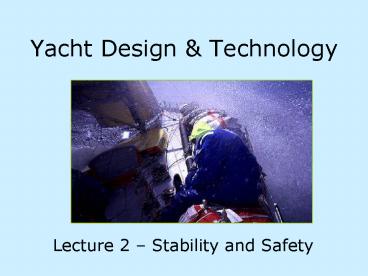Yacht Design - PowerPoint PPT Presentation
1 / 37
Title:
Yacht Design
Description:
Generation of Righting Moment. Yacht upright & in equilibrium ... Modern Cruiser/Racer. Lighter displacement, greater beam & higher centre of gravity ... – PowerPoint PPT presentation
Number of Views:52
Avg rating:3.0/5.0
Title: Yacht Design
1
Yacht Design Technology
- Lecture 2 Stability and Safety
2
Lecture Contents
- Recap concepts of stability
- Influence of hull shape on stability
- Water Ballast Canting Keels
- Safety
- Types of capsize
- Re-righting
3
Generation of Righting Moment
Yacht upright in equilibrium Mass of yacht in
air is equal to mass of fluid displaced Buoyancy
force acts upwards Displacement force acts
downwards
4
Generation of Righting Moment
Yacht heels B moves to one side G remains in
constant position Intersection of B line of
action and centreline is Metacentre Yacht will
return to upright since GZ, righting moment, is
positive
- M
5
Generation of Righting Moment
GZ is negative yacht will continue to roll and
will capsize
6
Righting Arm or GZ curve
7
Righting Arm, GZ Curve
- As heel angle increases, G B separation
increases to maximum - GZ then reduces to zero at limit of positive
stability - If yacht released at angle less than limit it
will return to upright - If yacht released at angle greater than limit it
will capsize
8
Righting Arm, GZ Curve
- If range of stability 180 degrees, it is
self-righting - GZ curve used to compare designs and assess
against regulations
9
Generation of Righting Moment
- At small angles GZ (righting arm) equal to
GMsinf - where f is the angle of heel
- Therefore GM is a simple measure of initial
stability
10
Influence of Hull Shape
- Stability characteristics dominated by beam and
centre of gravity - GM KB BM - KG
- Lower centre of gravity increase in stability
- since BM I/V
- Increase in beam reduction in displacement and
increase in stability
11
Different Hull Forms
12
GZ curves for different Yachts
13
Traditional Cruiser
- Heavy displacement, narrow beam low centre of
gravity - Relatively low initial stability since beam is
small - Stability increases until 90 degrees
- Range of stability is 160 degrees
14
Modern Cruiser/Racer
- Lighter displacement, greater beam higher
centre of gravity - Greater initial stability since greater beam
- Stability increases until 60 degrees
- Lower range of stability, 132 degrees
15
Modern Catamaran Cruiser
- Extreme beam. Light displacement with no ballast
high centre of gravity - Very high initial stability, but restricted to
small angles - Windward hull emerges from water at 10 degrees
and righting arm reduces rapidly - Lower range of stability, 80 degrees
- Very stable when inverted
16
Righting moment curves for different Yachts
17
Righting moment curves
- Yacht will be in equilibrium in terms of heel
angle when - righting moment heeling moment
- For identical rigs
- traditional yacht heel 30 degrees
- modern yacht heel 25 degrees
- catamaran heel 5 degrees
18
Freeboard
- Freeboard has significant effect on stability at
angles greater than deck edge immersion
19
Coachroof Cockpit Volumes
- A large coachroof increases distance between
buoyancy and C of G hence increases stability
at 90 degrees. - Cockpit has little effect on stability because
remains above waterline at most angles
Coachroof
Flush deck
20
Coachroof Cockpit Volumes
21
Hull Flare
- Increasing flare has a similar effect to an
increase in freeboard
22
Water Ballast
- To improve sailing performance by a reduction in
heel angle, ballast is frequently moved, or added
to the windward side of the yacht. - eg. moving crew or water tanks
23
Water Ballast
24
Canting Keel
- Another technique to increase righting moment is
to use a canting keel
25
Canting Keel
- Current Regulations
- Both Yachting Australia Open 60 class limits
max static heel angle to 10 degrees. Plus
self-righting test for Open 60 without rig. - Volvo 70 specifies minimum capsize angle of 115
deg with keel at max cant which is limited to 40
degrees, plus self-righting test
26
Canting Keel
27
Monohull - Casualty Statistics
RNLI lifeboat launches (5 year period)
28
Multihull - Casualty Statistics
RNLI lifeboat launches (5 year period)
29
Types of Capsize
- Overpowered by the wind
- potential hazard for vessel with low range of
stability i.e. less than 90 degrees - Knocked down by a gust or squall
- can happen to any craft, not a hazard if
structure remains buoyant and stable at large
angles - Rolled by a breaking wave
- small craft more likely to encounter waves large
enough to capsize them
30
Capsize by Breaking Wave
- Research concentrated on this mechanism since
1979 Fastnet Race (many yachts rolled or
capsized, 15 lives lost) - Narrow forms less vulnerable than wide forms
- Conclusion that little to be gained in
attempting to reduce vulnerability of monohull
yacht to capsize - Important consideration is that capsized yacht
re-rights
31
Re-Righting
Tank tests solitary waves
32
Re-Righting
Tank tests irregular waves
33
Re-Righting Effect of Coach House
34
Re-Righting Effect of Hull Form
35
Re-Righting Effect of Mast
36
Recap/reflect
37
(No Transcript)































